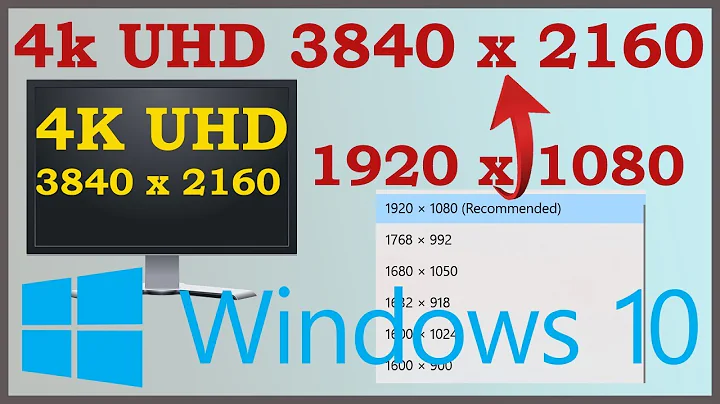How to set display resolution via PowerShell on Win10 Pro
Solution 1
Not sure where you got your example from but in a native powershell there is no command to set the resolution.
I use AutoHotKey. You can build your own script there or use an example from the net.
Or you could write your own function, that can be called from powershell: see here
And of course there are several 3rd party tools depending on your requirements. Here's one example that works with a script as well or here are 7 others. What exactly are you trying to do?
Solution 2
Per Albin's answer:
Make a setResolution.ps1 file with the following contents (src):
Function Set-ScreenResolution {
<#
.Synopsis
Sets the Screen Resolution of the primary monitor
.Description
Uses Pinvoke and ChangeDisplaySettings Win32API to make the change
.Example
Set-ScreenResolution -Width 1024 -Height 768
#>
param (
[Parameter(Mandatory=$true,
Position = 0)]
[int]
$Width,
[Parameter(Mandatory=$true,
Position = 1)]
[int]
$Height
)
$pinvokeCode = @"
using System;
using System.Runtime.InteropServices;
namespace Resolution
{
[StructLayout(LayoutKind.Sequential)]
public struct DEVMODE1
{
[MarshalAs(UnmanagedType.ByValTStr, SizeConst = 32)]
public string dmDeviceName;
public short dmSpecVersion;
public short dmDriverVersion;
public short dmSize;
public short dmDriverExtra;
public int dmFields;
public short dmOrientation;
public short dmPaperSize;
public short dmPaperLength;
public short dmPaperWidth;
public short dmScale;
public short dmCopies;
public short dmDefaultSource;
public short dmPrintQuality;
public short dmColor;
public short dmDuplex;
public short dmYResolution;
public short dmTTOption;
public short dmCollate;
[MarshalAs(UnmanagedType.ByValTStr, SizeConst = 32)]
public string dmFormName;
public short dmLogPixels;
public short dmBitsPerPel;
public int dmPelsWidth;
public int dmPelsHeight;
public int dmDisplayFlags;
public int dmDisplayFrequency;
public int dmICMMethod;
public int dmICMIntent;
public int dmMediaType;
public int dmDitherType;
public int dmReserved1;
public int dmReserved2;
public int dmPanningWidth;
public int dmPanningHeight;
};
class User_32
{
[DllImport("user32.dll")]
public static extern int EnumDisplaySettings(string deviceName, int modeNum, ref DEVMODE1 devMode);
[DllImport("user32.dll")]
public static extern int ChangeDisplaySettings(ref DEVMODE1 devMode, int flags);
public const int ENUM_CURRENT_SETTINGS = -1;
public const int CDS_UPDATEREGISTRY = 0x01;
public const int CDS_TEST = 0x02;
public const int DISP_CHANGE_SUCCESSFUL = 0;
public const int DISP_CHANGE_RESTART = 1;
public const int DISP_CHANGE_FAILED = -1;
}
public class PrmaryScreenResolution
{
static public string ChangeResolution(int width, int height)
{
DEVMODE1 dm = GetDevMode1();
if (0 != User_32.EnumDisplaySettings(null, User_32.ENUM_CURRENT_SETTINGS, ref dm))
{
dm.dmPelsWidth = width;
dm.dmPelsHeight = height;
int iRet = User_32.ChangeDisplaySettings(ref dm, User_32.CDS_TEST);
if (iRet == User_32.DISP_CHANGE_FAILED)
{
return "Unable To Process Your Request. Sorry For This Inconvenience.";
}
else
{
iRet = User_32.ChangeDisplaySettings(ref dm, User_32.CDS_UPDATEREGISTRY);
switch (iRet)
{
case User_32.DISP_CHANGE_SUCCESSFUL:
{
return "Success";
}
case User_32.DISP_CHANGE_RESTART:
{
return "You Need To Reboot For The Change To Happen.\n If You Feel Any Problem After Rebooting Your Machine\nThen Try To Change Resolution In Safe Mode.";
}
default:
{
return "Failed To Change The Resolution";
}
}
}
}
else
{
return "Failed To Change The Resolution.";
}
}
private static DEVMODE1 GetDevMode1()
{
DEVMODE1 dm = new DEVMODE1();
dm.dmDeviceName = new String(new char[32]);
dm.dmFormName = new String(new char[32]);
dm.dmSize = (short)Marshal.SizeOf(dm);
return dm;
}
}
}
"@
Add-Type $pinvokeCode -ErrorAction SilentlyContinue
[Resolution.PrmaryScreenResolution]::ChangeResolution($width,$height)
}
Set-ScreenResolution -Width 1024 -Height 768
Then the file can be executed from powershell as follows
`C:\path-to-file\setResolution.ps1`
Related videos on Youtube
A__
Updated on September 18, 2022Comments
-
 A__ almost 2 years
A__ almost 2 yearsI was asked by a client's IT admin to "write a powershell script that sets the resolution manually on bootup". Presumably it is possible if they're asking me to do this. I have absolutely no experience with powershell. My scripts/commands and their errors are as follows:
Set-DisplayResolution -Width 1024 -Height 768Set-DisplayResolutionis not recognized as the name of a cmdlet, function, script file, or operable program.Set-ScreenResolution -Width 1024 -Height 768Set-ScreenResolutionis not recognized as the name of a cmdlet, function, script file, or operable program.SetDisplayResolution -Width 1024 -Height 768SetDisplayResolutionis not recognized as the name of a cmdlet, function, script file, or operable program.What am I missing? Thank you.
-
 G-Man Says 'Reinstate Monica' over 4 yearsPlease don’t include answers in questions. Post your answer as an answer and edit it out of the question.
G-Man Says 'Reinstate Monica' over 4 yearsPlease don’t include answers in questions. Post your answer as an answer and edit it out of the question. -
CodeFox over 3 years
Set-DisplayResolutionis a commandlet from the ServerCore PowerShell module and seems not to be available on Windows 10. -
Jaakko over 3 yearsCan confirm what @CodeFox said. Running
Set-DisplayResolution -Width 1024 -Height 768on Windows Server 2019 worked out of the box.
-
-
 A__ over 4 yearsI'm trying to have the resolution set automatically when the machine boots (I realize the resolution should persist through a power cycle and/or is hardware-dependent, but just accept this as presupposition for the given scenario).
A__ over 4 yearsI'm trying to have the resolution set automatically when the machine boots (I realize the resolution should persist through a power cycle and/or is hardware-dependent, but just accept this as presupposition for the given scenario). -
 Albin over 4 years@A__ how many screens?
Albin over 4 years@A__ how many screens? -
 A__ over 4 yearsHow would that powershell function you linked be organized? Would I put that inside a ps1 script, followed by the actual call to it (
A__ over 4 yearsHow would that powershell function you linked be organized? Would I put that inside a ps1 script, followed by the actual call to it (Set-ScreenResolution -Width 1024 -Height 768) inside the script as well? -
 A__ over 4 yearsone 4k display ////
A__ over 4 yearsone 4k display //// -
 Albin over 4 years@A__ as shown in the paramter definition
Albin over 4 years@A__ as shown in the paramter definitionparam()would have guessedSet-ScreenResolution 1024 768but I'm propable wrong since the script says in it's example it should beSet-ScreenResolution -Width 1024 -Height 768. Haven't used my own function in powershell for quite a while, I'm propable mistaken, just in case: try both! ;) -
 A__ over 4 yearsThanks, the solution was to include that linked powershell function immediately followed by the call to it, with the
A__ over 4 yearsThanks, the solution was to include that linked powershell function immediately followed by the call to it, with theSet-ScreenResolution -Width 1024 -Height 768syntax, in the ps1 file. -
 Saaransh Garg over 2 yearsNote: This may look like a spam but it isn't, I checked it.
Saaransh Garg over 2 yearsNote: This may look like a spam but it isn't, I checked it. -
 Admin about 2 yearsYour answer could be improved with additional supporting information. Please edit to add further details, such as citations or documentation, so that others can confirm that your answer is correct. You can find more information on how to write good answers in the help center.
Admin about 2 yearsYour answer could be improved with additional supporting information. Please edit to add further details, such as citations or documentation, so that others can confirm that your answer is correct. You can find more information on how to write good answers in the help center.





